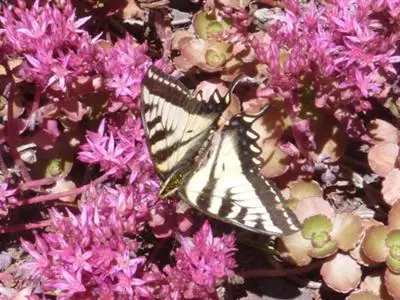
by Jacki
(Grand Forks, B.C. Canada)

The vividly striped black and yellow swallowtail butterfly is probably the most easily recognizable of all the big butterflies in southern British Columbia.
The males patrol a set area, looking for nectar plants and female swallowtail butterflies. The adults have only a proboscis, or long flexible tube for sucking the nectar from Sedum and other plants. They will be attracted to many plants in a butterfly garden or nectar corridor
The caterpillars have chewing mouthparts, which can do a lot of damage to to plants.
The favored host plant for the caterpillars of the Anise Swallowtail are dill and several other similar plants such as parsley and rue, where they’ll lay their eggs. The caterpillars are huge and green, and very identifiable by the eyes on their tail end. This is to give birds a warning – they are not that palatable to birds.
The eggs are laid in late July to hatch in August, when the caterpillars feed copiously. They pupate in a chrysalis, and hatch the following year. This is an excellent reason why you shouldn’t be too hasty to clean up your garden – the chrysalis look just like a dead leaf, and it would be easy to overlook them and burn them with the other garden refuse.
Pale Swallowtail larvae are hosted by birch trees, and using the leaf as a blanket, they roll up in a tube for protection, making a web to hold it all together.
See more butterflies here:
Great Spangled Fritillary Butterfly




